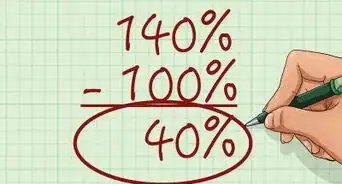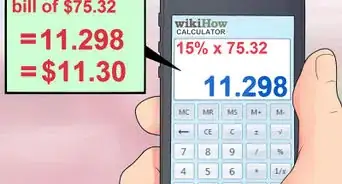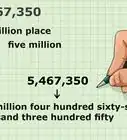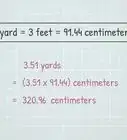This article was co-authored by wikiHow staff writer, Finn Kobler. Finn Kobler graduated from USC in 2022 with a BFA in Writing for Screen/Television. He is a two-time California State Champion and record holder in Original Prose/Poetry, a 2018 finalist for the Los Angeles Youth Poet Laureate, and he's written micro-budget films that have been screened in over 150 theaters nationwide. Growing up, Finn spent every summer helping his family's nonprofit arts program, Showdown Stage Company, empower people through accessible media. He hopes to continue that mission with his writing at wikiHow.
There are 16 references cited in this article, which can be found at the bottom of the page.
This article has been viewed 2,303 times.
Learn more...
Do you wish you could do more math in your head? Do you find conventional arithmetic difficult? Then the Trachtenberg method is perfect for you! Developed by renowned engineer Jakow Trachtenberg, this method(s) uses rapid mental division, multiplication, and addition to compute large numbers quickly! Keep reading and we’ll teach you what the Trachtenberg Method really is, how it was developed, and how to use it on all kinds of multi-digit math problems.
Things You Should Know
- When adding using the Trachtenberg method, remember the rule of 11. Totals should never be higher than 11 and, if they are, subtract 11 immediately.
- Multiply using the Trachtenberg method by adding 00’s equal to the number of digits in your multiplier. For example, if you’re multiplying a number by 14, add 2 0’s.
- Divide using the Trachtenberg method by separating your answer column into three rows: two for dividends and one for a working figure.
- Unlike traditional multiplication, the Trachtenberg Method has you carry the 10 instead of the 1.
Steps
Adding
-
1Place all your numbers in rows, adding 00s so the digits are all equal. The best way to begin using the Trachtenberg Method to add large numbers is to place all the numbers you wish to add in rows. If certain numbers have higher place values, add 00’s to the beginning of smaller ones so the amount of digits in each number is the same.[2]
- For example, if you were trying to add 93, 472, 65 and 3551, you would add a 0 to 472 and a 00 to 93 and 65, so that each of these numbers had the same amount of columns. This would give you 4 rows. Row 1 would have 0093, row 2 would have 0472, row 3 would have 0065, and row 4 would have 3551.
-
2Remember the rule of 11. Adding using the Trachtenberg method is a lot like traditional addition—with one key difference. When adding the initial values of your digits using the Trachtenberg method, remember that values should never exceed 11. If they do, immediately subtract 11 from the value. Make a mental note how many times you subtract 11 in each column. This rule of 11 stops applying after you begin using your initial added value to calculate your final total.[3]
-
3Add the digits of each column, subtracting 11 when necessary. The next step of the Trachtenberg Method is very similar to traditional addition. Add up the numbers in each column, starting with the smallest place value, to get the first step of your added value.[4]
- For example, in the units or ones column of 0093 + 0472 + 0065 + 3551, add 3 from 0093, 2 from 0472, 5 from 0055, and 1 from 3551. This total would be 11, which would need to be subtracted due to the rule of 11. This would give you a value of 0.
-
4Create a row below your added value for the 11s in each column. Once you’ve used addition to create your added value (the first total sum of your numbers), add another row below directly this total. This new row is where you'll include the final tally of all of the 11s you subtracted in each column during the previous step.[5]
- Using 0093, 0472, 0065, and 3551 as an example, this would tally up to one 11 subtracted in the ones column, two 11s subtracted in the tens column (9 + 7 = 16 - 11 and 5 + 6 = 11- 11), xero 11s subtracted in the hundreds column, and zero 11s subtracted in the thousands column. So add a row with 0021 below the added value of 3950 (since 3 + 2 + 5 + 1 - 11 = 0, 9 + 7 - 11 + 6 - 11 + 5 = 5, 0 + 4 + 0 + 5 = 9, and 0 + 0 +0 +0 = 3).
-
5Add the ones digit of the added value to the ones digit of the 11 row. Now, you’ll begin calculating your final total. After you’ve created a row for your 11s, add the ones digit (the rightmost digit with the lowest place value) of this row to the ones digit of your added value.[6]
- Using the added value of 3950 with an 11s row of 0021, the ones digit of your final total would be 1.
-
6Add up the remaining place values of your final total using L shapes. While the ones digit is calculated using direct addition, for the other columns of your final total, add 3 numbers: the number of your initial added value, the number from the 11 row directly below it, and the number from the 11 row to the bottom right of it. Use this L pattern of addition for the remaining columns.[7]
- For example, with the numbers 3950 and 0021, add the L shape patterns of 5, 2, and 1; 9, 0, and 2; and 3, 0, and 0.
- Then, final total in your tens column would be 8 (5 + 2 + 1), it would be 1 in the hundreds column (9 + 0 + 2, which equals 11, carry the 1 because the rule of 11 now no longer applies) and it would be 4 in the thousands column ( 3 + 0 + 0 +1 the carried one). Therefore, your final total (and the correct answer) would be 4181. Voila!
Multiplying
-
1Add 0s to your multiplicand. The first step in using the Trachtenberg method to multiply numbers with two or more digits is to add 0s to your multiplicand (the number you’re trying to multiply; usually the one with a higher value or more digits) equal to the amount of digits in your multiplier (the number you’re multiplying your multiplicand by). If there are 2 digits in the multiplier, add 2 0s to the beginning of your multiplicand. If it’s a 4-digit number, add 4 and so on.[8]
- For example, if you’re trying to multiply 972 by 18, add 2 0’s before you do any real mental multiplication so your multiplicand is now 00972.
-
2Create outer pairs, starting with the ones digit of each number. The Trachtenberg method multiplies the multiplicand with one digit of the multiplier at a time, then adds this pair of digits together. Start creating outer pairs by pairing the multiplier’s one’s column with each digit in the multiplicand.[9]
- If you were multiplying 00972 by 18, your first outer pair would be 8 and 2, your second outer pair would by 8 and 7, your third outer pair would be 8 and 9, your fourth outer pair would be 8 and 0, and your fifth outer pair would be 8 and 0.
-
3Create inner pairs, with the tens digit to the right of each outer pair. After you’ve created your “outer pairs,” create “inner pairs” connecting the tens column of your multiplier with the digits in the multiplicand. The first inner pair will always start with the column directly to the right of the first outer pair (which is the ones place value), meaning the first pair is never technically a pair, since the number is connected to nothing.
- Your first inner pair of 00972 x 18 would be 1 and nothing, your second pair would be 1 and 2, your third pair would be 1 and 7, your fourth pair would be 1 and 9, and your fifth pair would be 1 and 0. (1 would not be paired with the final 0, since it always has to be to the right of the outer pair.)
- If your multiplier is 3 digits or more, no problem! Just know you’ll have 2 inner pairs, the first 1 digit to the right of the outer pair, and the second 2 digits to the right. Both inner pairs will remain unpaired at first and you’ll add up the total of all three digit pairs each time.
-
4Add all the multiplied outer and inner pairs and carry the tens value. Once you’ve gotten a grasp on the outer/inner pair system, begin multiplying your equation. Multiply the first outer pair and the first inner pair, then add these multiplied totals together. (Your first inner pair value should always equal 0 since there is no number in the multiplicand for your first inner pair.) Place the ones value of your added pairs’ sum in your final total and carry the tens value to the next addition of pairs. Repeat this process until the outer pair reaches the final 0 in your multiplicand.[10]
- For example, the first number (the number in the ones column) of your final total value for 00972 x 18 would be 6, because 8 x 2 = 16 and 1 is not yet paired. Add the 6 (the ones value) to the final total, and carry the 1. The number in the 10s column would be 9 because 56 (8 x 7) + 2 (1 x 2) + 1 (carried) = 59, the number in the hundreds column would be 4 because 72 (8 x 9) + 7 (1 x 7) + 5 (carried) = 84, the number in the thousands column would be 7 because 0 (8 x 0) + 9 (1 x 9) + 8 (carried) = 17, and the number in the ten thousands column would be 1 because 0 (8 x 0) + 0 (1 x 0) + 1 (carried) =1. That would make the final answer 17,496.
Dividing
-
1Separate your answer column into three rows. Either mentally or on a page, create three rows to do your division calculations. The top row should be your dividend (the number you’re trying to divide by; usually the one with more digits). The second row should be a working figure (W fig) for you to use, and the third row should be your PD (or partial dividend: the number you’ll be dividing by the divisor using the Trachtenberg method).[11]
-
2Divide your dividend’s highest place value by your divisor’s highest place value. Begin calculating the first row of your partial dividend by bringing the highest place value of your true dividend down and dividing this number by the highest place value of your divisor. Do not worry about any remainders from this division.[12]
- For example, if you were dividing 9471 by 77, bring the 9 down to your PD row and divide that 9 by 7. This equals 1 which now makes the first place value of your quotient. The remainder is irrelevant.
-
3Use the quotient from your PD division to calculate your NT product. NT stands for N x T. N represents the Number of the whole result while T represents the Tens digit of a result. To calculate your NT product, multiply each place value of your divisor by the first digit of your quotient. Then, add the N from the highest place value in your divisor to the T of the smaller value(s).[13]
- If you were dividing 9471 by 77, your NT product would be 7, because N (7 X 1 = 07) + T (7 x 1 = 07, the tens placement is 0) = 7.
-
4Subtract your NT product from the most recent digit in your PD row. After you’ve calculated your NT product, subtract this number from the number you last used for your partial dividend to divide for your final quotient.[14]
- After getting an NT product of 7 for 9471, subtract 7 (the NT product) from 9 for a value of 2.
-
5Carry the PD - NT number to your W fig row. After you’ve subtracted the NT product from your partial dividend, carry the remaining value to the next column of the working figure row. This number will become the tens value of your newest working figure.[15]
-
6Carry down the dividend’s next place value to the same W fig column. After you’ve carried the PD - NT value to become the tens placement of your newest working figure number, carry down the next digit of the dividend to become the ones placement for this same number.[16]
- After carrying 2 (the PD 9 - NT 7 value) to the W fig row of 9471, carry down the 4 to create a value of 24 in the W fig row.
-
7Subtract the remaining U of your NT product from the new W fig number. Now that you have a multi-digit number in the working figure row, subtract the remaining units from your NT equation from this number. Whatever number W fig - U of NT equals, carry that number down to the PD column to use as your next partial dividend.[17]
- For 9471, subtract the remaining units of your NT, 7 (because 7 x 1 = 07), from your working figure of 24 to get a value of 17. Place 17 in the PD row next to 9.
-
8Divide the next number in the PD row by the highest place value of the divisor. Now that you have your next PD calculated, divide this PD by the highest place value of your divisor for the next place value of your quotient.[18]
- Using 9471/77 as an example, after getting 17 for your PD row, divide 17 by the 7 in 77 for a value of 2. Add the 2 next to 1 in your final quotient (not worrying about the remainder). Now, you know the first two digits of your final quotient will be 12.
-
9Repeat the process. Now that you’ve done all the necessary steps, continue this process of calculating NT, subtracting it from PD, carrying the next place value down from the dividend to W fig and subtracting U of NT from W fig to get your final quotient. If your final quotient has no remainder, final PD should equal 0.[19]
- Using this method, the final quotient of 9471 divided by 77 = 123, with W figs of 24 (PD 9 - NT 7, carry down the 4), 27 (PD 17 - NT 15, carry down the 7), and 01 (PD 23 - NT 23, carry down the 1) and PDs of 9, 17 (W fig 24 - U 7), 23 (W fig 27 - U 4), and 0 (W fig 1 - U1).
References
- ↑ https://www.cambridge.org/core/journals/mathematical-gazette/article/abs/trachtenberg-speed-system-of-basic-mathematics-translated-and-adapted-by-ann-cutler-and-rudolph-mcshane-pp-270-895-isbn-0285626787-souvenir-press/6D733A363FD1BE187152EE55F8DD0346
- ↑ https://pdfroom.com/books/trachtenberg-system/o75XZDANgaG
- ↑ https://drtayeb.files.wordpress.com/2011/05/trachtenberg-system.pdf
- ↑ https://youtu.be/K5xsviPjLXU?t=69
- ↑ https://youtu.be/QI9E6LJykNk?t=75
- ↑ https://youtu.be/QI9E6LJykNk?t=147
- ↑ https://youtu.be/QI9E6LJykNk?t=154
- ↑ https://academickids.com/encyclopedia/index.php/Trachtenberg_system
- ↑ https://youtu.be/fwbFXMMp9_k?t=95
- ↑ https://gbsnote.com/trachtenberg-multiplication/
- ↑ https://youtu.be/M27TlN2L2a0?t=124
- ↑ https://pdfroom.com/books/trachtenberg-system/o75XZDANgaG
- ↑ https://youtu.be/M27TlN2L2a0?t=182
- ↑ https://youtu.be/M27TlN2L2a0?t=206
- ↑ https://youtu.be/M27TlN2L2a0?t=215
- ↑ https://drtayeb.files.wordpress.com/2011/05/trachtenberg-system.pdf
- ↑ https://youtu.be/M27TlN2L2a0?t=224
- ↑ https://youtu.be/M27TlN2L2a0?t=245
- ↑ https://youtu.be/M27TlN2L2a0?t=245
































































